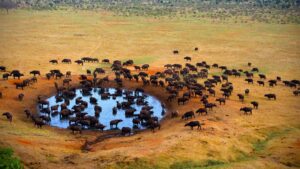
- Profile
- Tour Operators
- Accommodation
- prev
- next
- Get directions
- Website
- Bookmark
- Share
- Become an influencer
- prev
- next
Overview
Brilliant on a magnificent scale, the Meru and Kora sister parks feature luxuriant jungle, coursing rivers, verdant swamp, khaki grasslands and gaunt termite cathedrals all under the sky’s great blue bowl. Little visited and utterly unspoilt, few places are comparable to the remote and rugged atmosphere found here. Visitors can see Grevy's zebras, elephants, Bohor reedbucks, hartebeests, pythons, puff adders, cobras, buffalos and more than 427 recorded species of birds.
Location
-
606, Athiru Gaiti, Meru, Kenya
Vital Park Information
Kenya
350 km
It is safe to swim in the sea and swimming pools, but it is not recommended to do so in lakes, rivers and open reservoirs as they may be infested with bilharzia parasites. Drinking water from these places is not advisable. Tap water is safe to drink unless otherwise indicated.
Kenyan shilling
January, February, March, June, July, August, September, October, December
Meru can be visited throughout the year, but wildlife viewing is best in the Dry season from June to September. Wildlife watching is usually more difficult during the long rains (March to May), and the short rains (October to November). During this time the weather may interfere with your enjoyment of game drives. Also, the grass tends to be very high making spotting animals more difficult. Elephants migrate out of the park in the rainy season and the roads in the rhino sanctuary might become impassable.




